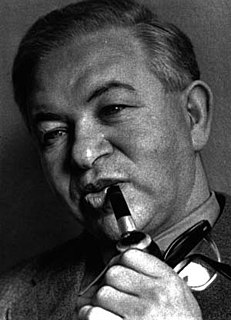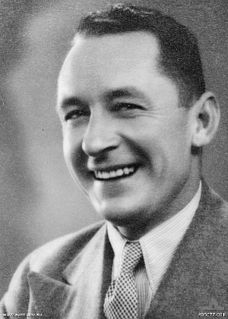
Walter Adolph Georg Gropius was a German architect and founder of the Bauhaus School, who, along with Alvar Aalto, Ludwig Mies van der Rohe, Le Corbusier and Frank Lloyd Wright, is widely regarded as one of the pioneering masters of modernist architecture. He is a founder of Bauhaus in Weimar (1919). Gropius was also a leading architect of the International Style.

Gottfried Semper was a German architect, art critic, and professor of architecture, who designed and built the Semper Opera House in Dresden between 1838 and 1841. In 1849 he took part in the May Uprising in Dresden and was put on the government's wanted list. Semper fled first to Zürich and later to London. Later he returned to Germany after the 1862 amnesty granted to the revolutionaries.

Arne Emil Jacobsen, Hon. FAIA 11 February 1902 – 24 March 1971) was a Danish architect and furniture designer. He is remembered for his contribution to architectural functionalism and for the worldwide success he enjoyed with simple well-designed chairs.

The Deutscher Werkbund is a German association of artists, architects, designers, and industrialists, established in 1907. The Werkbund became an important element in the development of modern architecture and industrial design, particularly in the later creation of the Bauhaus school of design. Its initial purpose was to establish a partnership of product manufacturers with design professionals to improve the competitiveness of German companies in global markets. The Werkbund was less an artistic movement than a state-sponsored effort to integrate traditional crafts and industrial mass production techniques, to put Germany on a competitive footing with England and the United States. Its motto Vom Sofakissen zum Städtebau indicates its range of interest.

Mart Stam was a Dutch architect, urban planner, and furniture designer. Stam was extraordinarily well-connected, and his career intersects with important moments in the history of 20th-century European architecture, including chair design at the Bauhaus, the Weissenhof Estate, the Van Nelle Factory, an important modernist landmark building in Rotterdam, buildings for Ernst May's New Frankfurt housing project then to Russia with the idealistic May Brigade, to postwar reconstruction in Germany.

Gridley James Fox Bryant, often referred to as G. J. F. Bryant, was a Boston architect, builder, and industrial engineer whose designs "dominated the profession of architecture in [Boston] and New England." One of the most influential architects in New England, he designed custom-made houses, government buildings, churches, schoolhouses, and private residences across the United States, and was popular among the Boston elite. His most notable designs are foundational buildings on numerous campuses across the northeastern United States, including Tufts College, Bates College, and Harvard College. He has been credited as one of the first modern architects in America, and at the height of his career he was the most commissioned architect in New England. He is also the most commissioned architect in Boston history.

Gottfried Böhm is a German architect and sculptor. His reputation is based on creating highly sculptural buildings made of concrete, steel, and glass. Böhm's first independent building was the Cologne chapel "Madonna in the Rubble". Böhm's most influential and recognized building is the Maria, Königin des Friedens or Nevigeser Wallfahrtsdom.

The Cremer & Wolffenstein architecture firm was founded in Germany in 1882 by Richard Wolffenstein (1846–1919) and Wilhelm Cremer (1854–1919) and existed up to the death of its two founders. During the so-called Gründerzeit in Berlin, the years of rapid industrial expansion in Germany at the end of the 19th century, they were a prolific firm in the various aspects of architecture. As one of the largest firms in Berlin at the turn of the century, they designed residential, commercial, transportation, government, and religious buildings. They built a number of synagogues, won second place in the 1882 competition to design the Reichstag, and were also involved in planning the Hochbahn overhead railway installation between Kreuzberg and Nollendorfplatz.

Hans Meerwein was a German chemist. Several reactions and reagents bear his name, most notably the Meerwein–Ponndorf–Verley reduction, the Wagner–Meerwein rearrangement, the Meerwein arylation reaction, and Meerwein's salt.

Paul Due was a Norwegian architect and significant contributor to the stations built by the Norwegian State Railways.

The architecture of Denmark has its origins in the Viking period, richly revealed by archaeological finds. It became firmly established in the Middle Ages when first Romanesque, then Gothic churches and cathedrals sprang up throughout the country. It was during this period that, in a country with little access to stone, brick became the construction material of choice, not just for churches but also for fortifications and castles.

Harvey Ellis was an architect, perspective renderer, painter and furniture designer. He worked in Rochester, New York; Utica, New York; St. Paul, Minnesota; Minneapolis, Minnesota; St. Joseph, Missouri; St. Louis, Missouri and Syracuse, New York.

The Elbphilharmonie is a concert hall in the HafenCity quarter of Hamburg, Germany, on the Grasbrook peninsula of the Elbe River.

Emil Lawrence Sodersten was an Australian architect active in the second quarter of the 20th century. His work encompassed the Australian architectural styles of Art Deco and Functionalist & Moderne. His design for the Australian War Memorial was "the first national architectural monument in Australia". The Australian Institute of Architects presents the Emil Sodersten Interior Architecture Award annually in his honour.

Franz Ferdinand Carl Andreas Meyer was a German civil engineer, known primarily as the creator of the Speicherstadt on Hamburg's waterfront.

Zachris Usko Nyström, known as Usko Nyström, was a Finnish architect and one of the most influential professors of architecture at Helsinki University of Technology; among his students were later notable architects Eliel Saarinen and Alvar Aalto. One of the pioneering architects of the early Art Nouveau or Jugendstil style in Finland at the end of the 19th and beginning of the 20th century, he continued to influence generations of students by introducing them to the style. Many of his key architectural works were made while he was in the architectural partnership Usko Nyström─Petrelius─Penttilä which operated from 1895 to 1908. His most famous work is the Grand Hôtel Cascade (1903) in Imatra.

Georg Peter Hermann Eggert was a German architect. He designed important public buildings such as the Frankfurt Main Station and the New Town Hall in Hannover, often in the style of Neo-Renaissance.

Bekenntnis der Professoren an den Universitäten und Hochschulen zu Adolf Hitler und dem nationalsozialistischen Staat officially translated into English as the Vow of allegiance of the Professors of the German Universities and High-Schools to Adolf Hitler and the National Socialistic State was a document presented on 11 November 1933 at the Albert Hall in Leipzig. It had statements in German, English, Italian, and Spanish by selected German academics and included an appendix of signatories. The purge to remove academics and civil servants with Jewish ancestry began with a law being passed on 7 April 1933. This document was signed by those that remained in support of the Third Reich.

Bernhard Georg Jacob Hanssen (1844–1911) was a German architect and politician.

Theodor Bülau was a German architect.





















